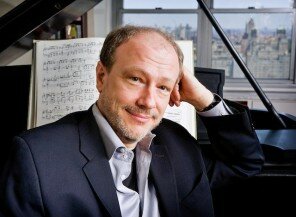This July sees the first year of artistic director James Ehnes’s stamp on the programming and artists presented at Seattle Chamber Music Society’s Summer Festival (running through July 29; tickets). The festival is in its 31st season, and Ehnes has been playing violin here for some 15 years: His choices show a continuity which will reassure audience, but also fresh ideas which will enliven the festival.
Among these has been bringing at least one work to each performance never played at the festival before—not easy when one remembers there have been between 12 and 20 concerts in each of 30 years, each with three or four works played, though many have been repeated more than once.
Opening night Monday at Nordstrom Recital Hall included the rarely-performed Variations for Violin, Cello and Piano, Op. 44, by Beethoven. He sketched it out in 1792, the year he reached 22 and was studying—not always fruitfully—with Haydn, but didn’t publish it for years after.
Although Beethoven had written some well-received works prior to this, the Variations seem more a student work, heavily leaning towards the piano part, played Monday by Jeewon Park. When each instrument has its limelight, the other two are not much more than accompaniment. Nevertheless, the work has its charm, and much of the performance, by Park, violinist Erin Keefe, and cellist Edward Aaron, gave it shape and nuance particularly in the lighter variations, though the musicians tended to be overly forceful when the music called for a forte.
 Those who attended the free pre-concert recital had the delight of hearing pianist Marc-André Hamelin give a superb performance of two of his own works: Theme and Variations (Cathy’s Variations) and Variations on a Theme of Paganini—this last a spinoff, or perhaps I should say a takeoff, on other famous Variations on the same theme.
Those who attended the free pre-concert recital had the delight of hearing pianist Marc-André Hamelin give a superb performance of two of his own works: Theme and Variations (Cathy’s Variations) and Variations on a Theme of Paganini—this last a spinoff, or perhaps I should say a takeoff, on other famous Variations on the same theme.
So often, great pianists are not great composers, but Hamelin, definitely a great pianist, has the depth and the imagination and the knowledge to write music which has the components to make it last. Cathy’s Variations, written for his fiancée about five years ago has a gentle flowing melody for a theme, largely in classical-romantic style and tonality, with variations which build and extend and embroider.
My neighbor turned to me afterward, commenting: “After that, I feel I know Cathy,” which seemed an appropriate compliment to the music. His brilliant Paganini Variations were clearly recognizable and impishly distorted, an excellent choice for this musically educated audience which caught all the insertions and nuances and chuckled often.
Ehnes himself with pianist Jon Kimura Parker performed Bartok’s Sonata No. 1 for violin and piano, the heart and soul of the ensuing concert. It’s a work which takes complete attention for the listener to absorb, and judging by the silence between movements, it received that. It also takes thorough understanding by the musicians in order to put it across, and that too it had. This was a stellar performance of a work written in the early 1920s which sounds as fresh and contemporary today, 90 years later, as it must have when written.
Brahms’ Quintet for Piano and Strings, Op. 34, which concluded the concert, received an intense, vigorous, sometimes even aggressive performance which began startlingly loud and continued that way. While there were many moments of extreme beauty and exquisite soft playing, and a synchronization of bowing between the two violins, Andrew Wan and Augustin Hadelich, which was a marvel to hear and behold, the performance was marred by too much forcing at every forte moment, turning each into an unneccessary quadruple forte.
Strings in Brahms’ time were all gut. Had they played this way in the 1860s when this was composed, strings would have snapped right and left during the performance. The lower registers of cellist Bion Tsang and violist David Harding were less noticeable in this regard, but Hamelin at the piano sounded equally overloud.
Maybe the performance would have sounded less pushed in a large concert hall, but this is chamber music, and Nordstrom holds only 500-plus seats. The idea of using performance practice—an approach to performing music in the context of its time—not only in Baroque music but in all music up to the present day, has been taking hold in many unexpected places, even in one of the last hold outs, the orchestra. Surely it is not too much to hope that chamber music players, particularly those of the caliber always present at Seattle Chamber Music Society’s concerts, could pay attention to this?